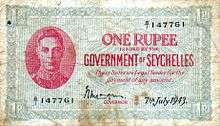Seychellois rupee
| Seychellois rupee | |
|---|---|
| roupie seychelloise (French) | |
|
25 cents | |
| ISO 4217 | |
| Code | SCR |
| Denominations | |
| Subunit | |
| 1/100 | cent |
| Symbol | SR or SRe |
| Banknotes | 10, 25, 50, 100, 500 rupees |
| Coins | 1, 5, 10, 25 cents, 1, 5, 10 rupees |
| Demographics | |
| User(s) |
|
| Issuance | |
| Central bank | Central Bank of Seychelles |
| Website | www.cbs.sc |
| Valuation | |
| Inflation | 7.5% |
| Source | Central Bank of Seychelles, January 2008 est. |
The rupee is the currency of the Seychelles. It is subdivided into 100 cents. In the local Seychellois Creole (Seselwa) language, it is called the roupi. The international currency code is SCR. The abbreviations SR and SRe are sometimes used.[1][2] Several other currencies are also called rupee.
Banknotes

British Colony
The British Legislative Council authorized the establishment of a Board of Commissioners of Currency through the Paper Currency Ordinance of 1914, which was enacted by C. R. M. O’Brien, the governor of the Colony of the Seychelles on 10 August 1914.[3] In 1914, the government produced emergency issues of notes for 50 cents, 1, 5 and 10 rupees.
Standard issue notes began to be issued in 1918, with notes for 50 cents and 1 rupee, followed by 5, 10 and 50 rupees in 1928. The 50 cents and 1 rupee notes were issued until 1951 and phased out in favor of the coins. 20- and 100-rupee notes were first introduced in 1968, whilst the 5-rupee note was replaced by a coin in 1972.
Independent Republic
In 1976, the Seychelles Monetary Authority took over the issuance of paper money, issuing notes for 10, 25, 50 and 100 rupees. This series featured the first president of the Seychelles, James Mancham and replaced all colonial notes issued prior to independence.
In 1979, there was a redesign, featuring a more socialist and modernized theme reminiscent of the René Regime. This series was also issued by the Central Bank of Seychelles when it took over full responsibility in the same year.
In 1989, a new series was introduced with better security features and colors.
In 1998, another more high-tech series was introduced with a more practical, ergonomic design. This series later saw an additional 500-rupee note first introduced in 2005.
2011 Update
On June 7, 2011, the Central Bank of Seychelles issued updated 50, 100 and 500 rupees notes with improved security features. Each of the three banknotes has a holographic patch instead of a foil sailfish which currently appears on the notes.
- On the 50-rupee note, the silver holographic sailfish alternates between the number 50 and an image of the Aldabra rail, a flightless bird.
- On the 100-rupee note, the gold holographic sailfish alternates between the number 100 and an image of the Seychelles giant tortoise.
- On the 500-rupee note, the gold holographic sailfish alternates between the number 500 and an image of the Seychelles scops owl.
Additional security upgrades include a 2.5-mm wide fluorescent security thread on the 50-rupee note, a 2.5-mm wide color-shifting security thread on the 100-rupee note, and a 3-mm wide color-shifting security thread on the 500-rupee note. The notes are also protected by De La Rue’s unique Gemini technology that fluoresces under ultraviolet light but appears normal in daylight.
The color schemes of the notes have been revised, with the notes being more green, red, and orange, respectively, than the notes currently in circulation. The new notes also carry the year of printing, as well as the signature of Pierre Laporte, the bank’s current governor. Existing notes remain legal tender and will be removed from circulation as they wear out.[4]
2016 Changes
In December 2016, the Central Bank of Seychelles is set to issue a new series of banknotes to commemorate 40 years of Seychelles' independence. The theme of this series is "Seychelles' Unique Biodiversity - the backbone of the economy".[5][6]
| 1968-1975 "Elizabeth II" Issue | |||
|---|---|---|---|
| Image | Denomination | Obverse | Reverse |
| 5 Rupees | Seychelles black parrot, Queen Elizabeth II | ||
| 10 Rupees | Tortoise, Queen Elizabeth II | ||
| 20 Rupees | Bridled tern, Queen Elizabeth II | ||
| 50 Rupees | Schoner, Queen Elizabeth II | ||
| 100 Rupees | Turtles, Queen Elizabeth II | ||
| Current SCR exchange rates | |
|---|---|
| From Google Finance: | AUD CAD CHF EUR GBP HKD JPY USD |
| From Yahoo! Finance: | AUD CAD CHF EUR GBP HKD JPY USD |
| From XE: | AUD CAD CHF EUR GBP HKD JPY USD |
| From OANDA: | AUD CAD CHF EUR GBP HKD JPY USD |
| From fxtop.com: | AUD CAD CHF EUR GBP HKD JPY USD |
See also
References
- ↑ Ministry Of Foreign Affairs - The Republic of Seychelles
- ↑ Currencies of the World
- ↑ Linzmayer, Owen (2012). "Seychelles". The Banknote Book. San Francisco, CA: www.BanknoteNews.com.
- ↑ Seychelles new 50-, 100-, and 500-rupee notes confirmed BanknoteNews.com. September 6, 2011. Retrieved on 2013-02-02.
- ↑ Seychelles new banknote family (B419-B422) reported for Dec. 2016 introduction Banknote News (banknotenews.com). November 3, 2016. Retrieved on 2016-11-05.
- ↑ The Central Bank of Seychelles will soon release a new family of banknotes and coins Central Bank of Seychelles (www.cbs.sc). Retrieved on 2016-11-06.
- Krause, Chester L.; Clifford Mishler (1991). Standard Catalog of World Coins: 1801–1991 (18th ed.). Krause Publications. ISBN 0873411501.
- Pick, Albert (1994). Standard Catalog of World Paper Money: General Issues. Colin R. Bruce II and Neil Shafer (editors) (7th ed.). Krause Publications. ISBN 0-87341-207-9.
External links
| Preceded by: Mauritian rupee Reason: became a separate crown colony in 1903 Ratio: at par |
Currency of Seychelles 1914 – |
Succeeded by: Current |
